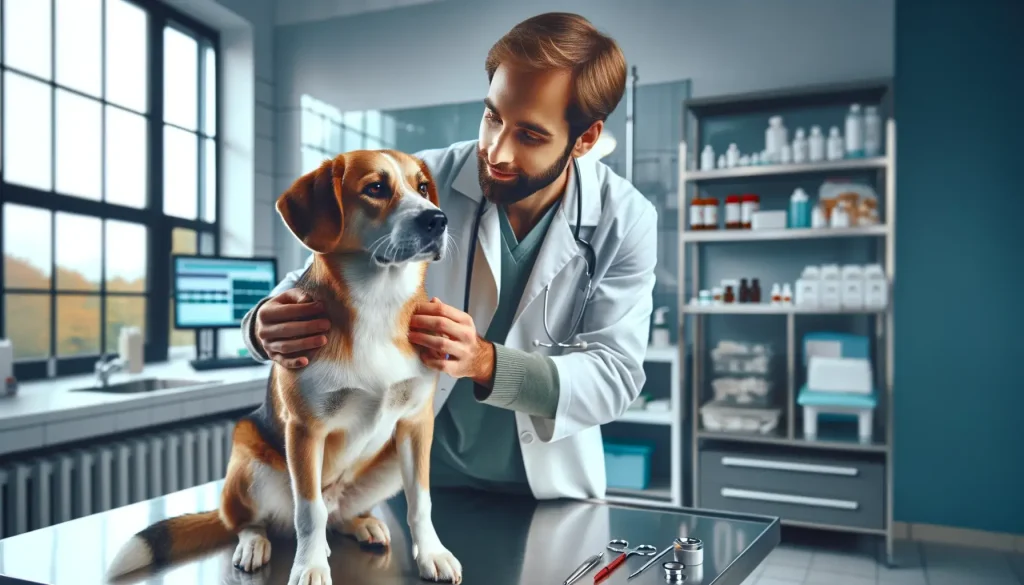
As a devoted pet owner and an expert in pet care and wellness, I’ve encountered the question many times: does spaying calm dogs down? It’s a topic swirled with myths, personal anecdotes, and scientific research. Spaying, the surgical removal of a female dog’s reproductive organs, is a significant decision for pet owners, guided by considerations for pet health, behavior management, and population control. The popular belief suggests that spaying can lead to a calmer, more docile pet. But what does the evidence say?
Exploring this subject is not only about understanding the physiological impact of spaying but also about debunking myths that have long influenced pet owner decisions. Drawing from veterinary insights and factual data, we aim to provide a comprehensive look into how spaying may or may not alter a dog’s behavior.
By delving into facts and statistics, interesting observations, and expert opinions, we will offer a clear perspective on whether spaying actually brings about behavioral changes in dogs. Is the widely held belief in a post-spaying calm a scientific fact, or merely a pet care myth? Let’s find out.
Facts Behind Spaying
When it comes to spaying dogs, understanding the behavioral changes that may occur post-surgery is crucial for any pet owner. It’s a topic that combines veterinary science with practical pet care, shedding light on common beliefs and scientific findings. Let’s dive into the significant aspects of how spaying may influence a dog’s behavior, based on collected data and expert opinions.
Aggression and Roaming: One of the most cited reasons for spaying is the reduction in aggressive tendencies and the urge to roam. Research indicates that spaying can indeed decrease aggression towards other dogs, especially in females. As for roaming, the desire to search for a mate is significantly reduced post-spaying, leading to potentially fewer instances of lost pets.
Sexual Behavior: It’s no surprise that removing a dog’s reproductive capability through spaying eliminates any future sexual behavior, such as mounting. This can alleviate awkward situations, especially for pet owners living in shared spaces or residential areas.
Urine Marking: Both male and female dogs are known to mark their territory with urine. Spaying can reduce this behavior, especially if the surgery is done before the first heat cycle in females. This leads to a cleaner, more pleasant home environment.
However, it’s essential to recognize that while spaying can influence some behaviors, it is not a cure-all. Other factors like training, environment, and genetics also play a significant role in a dog’s behavior post-surgery.
For pet owners considering spaying, these factors highlight the potential for a more manageable and stress-free pet experience. Yet, the importance of comprehensive training and socialization in ensuring a well-behaved pet remains paramount. Understanding the multifaceted impact of spaying can help pet owners make informed decisions that benefit both their furry friends and their household.

Home Care Tips After Spaying Your Dog
After making the decision to spay your dog, knowing how to care for your fur friend at home is essential. Proper post-operative care ensures a smooth recovery and a quick return to normal activities. Here are some straightforward and effective home care tips for post-spaying recovery:
- Limit Activity: Keep your dog calm and limit their physical activity for at least 10 to 14 days after surgery. Too much movement can disrupt the healing process and increase the risk of complications. Use a leash for short bathroom breaks.
- Watch the Incision Site: Check the incision daily for signs of infection, such as redness, swelling, or discharge. It’s normal for there to be a little redness and swelling immediately after surgery, but it should gradually improve, not worsen.
- E-collar or Protective Clothing: Dogs tend to lick their wounds, which can lead to infection or open stitches. An Elizabethan collar (E-collar) or protective clothing can prevent this, ensuring the incision heals properly.
- Follow Veterinarian Guidance: Your vet will provide specific instructions on care post-surgery. This may include how to clean the wound, what signs of complications to look out for, and when to return for a follow-up visit.
- Maintain a Clean Environment: Keeping your dog’s living area clean reduces the risk of infection. Ensure their bed is clean, and limit exposure to dirt and debris until the incision has fully healed.
Proper post-operative care is crucial after spaying. It not only aids in a smoother recovery but also helps in preventing complications. By following these simple tips, you can ensure your dog gets back on their paws in no time. Remember, each dog is unique, and some might recover quicker than others. Always keep in touch with your veterinarian if you have any concerns during the recovery phase.

Knowing When It’s Time to Visit the Vet
Understanding the right time to consult with a veterinarian is crucial for your dog’s recovery after spaying. While the process is typically straightforward, being vigilant about possible complications is vital for pet owners. Here are some situations where a visit to the vet is necessary:
- Increased Redness, Swelling, or Discharge: Some swelling and redness are expected after spaying, but if the condition worsens or doesn’t improve, it may indicate infection.
- Fever: A fever can be a sign of infection. If your dog seems unusually lethargic or refuses food, checking their temperature can help determine if there’s a problem.
- Stitches Open: If the stitches come loose or the incision opens, it’s critical to get veterinary care immediately to prevent infection and ensure proper healing.
- Persistent Licking or Chewing: Despite using an E-collar or protective clothing, some dogs manage to irritate the site. Excessive licking or chewing can delay healing or introduce bacteria.
- Unusual Behavior: Changes in behavior, such as increased aggression, depression, or refusal to eat, can indicate discomfort or complications from the surgery.
Regular post-spay check-ups are also part of the proactive steps to ensure your dog’s well-being. Such visits allow the vet to monitor the healing process and address any concerns immediately. It’s also a good time to discuss any changes in your dog’s behavior and get professional advice on managing them.
Communication with your vet is key. If you’re unsure or worried about something, it’s better to ask for advice than wait for the issue to escalate. A vet visit might seem daunting, especially after the emotional toll of surgery, but it’s essential for your dog’s quick and smooth recovery.

Myths and Truths about Spaying Dog
When it comes to making decisions about spaying your dog, misinformation can often cloud judgment. Let’s tackle some widespread myths and provide clear, factual information to help pet owners understand what spaying entails and its effects.
Spaying Causes Laziness and Weight Gain
A common misconception is that a spayed dog becomes lazy and gains weight as a direct result of the procedure. However, the truth is more about metabolism and activity levels. Spaying may slightly lower a dog’s metabolic rate, but weight gain can be managed with a proper diet and regular exercise. Laziness is not a side effect of spaying; activity levels may vary due to many factors but are not directly affected by spaying.
It’s Best to Let Your Dog Have One Litter Before Spaying
This myth suggests that female dogs should have one litter of puppies for health or behavioral benefits before being spayed. However, veterinary research indicates that spaying before the first heat cycle significantly reduces the risk of mammary tumors and eliminates risks of uterine infections and cancers. There’s no documented behavioral or health advantage in allowing a dog to have a litter before spaying.
Spaying Changes a Dog’s Personality
Some worry that spaying a dog will alter its personality. While hormonal changes can affect behavior (reducing aggression and roaming, as previously mentioned), a dog’s fundamental personality remains intact. Spaying doesn’t change who your dog is; it may only reduce certain behaviors linked to reproductive instincts.
Spaying Is Dangerously Invasive and Risky
While spaying is a surgical procedure that involves anesthesia, it is a routine operation performed by veterinarians worldwide. Complications are rare, and risks are much lower than the potential health risks of an unspayed dog, such as pyometra or complications during pregnancy and birth.
Dispelling these myths is crucial for pet owners to make educated decisions based on facts rather than fear or misinformation. Spaying offers numerous health and behavioral benefits for dogs and is an essential component of responsible pet ownership. By consulting with a trusted veterinarian, you can make the best choice for your pet’s wellbeing.
Communication with your vet is key during this process. Understanding the benefits, addressing concerns, and following through with post-operative care will ensure your dog leads a healthy and happy life.
Beginner Guide to Raising Quail at Home
What are the Signs of a Dog Concussion?
What Causes Your Dog’s Ears to Smell Bad?
When your dog’s ears start to emit an unpleasant odor, it might leave you puzzled…
Methimazole Treatment for Cat Hyperthyroidism
Methimazole plays a crucial role in managing feline hyperthyroidism, a condition marked by an overactive…
Got Hummingbirds in your Backyard? Here’s How to Care for Them.
Why Does Your Cat Pee Outside the Litter Box?
Cat’s Litter Box Issues It’s not uncommon for cat owners to face the frustrating dilemma…




